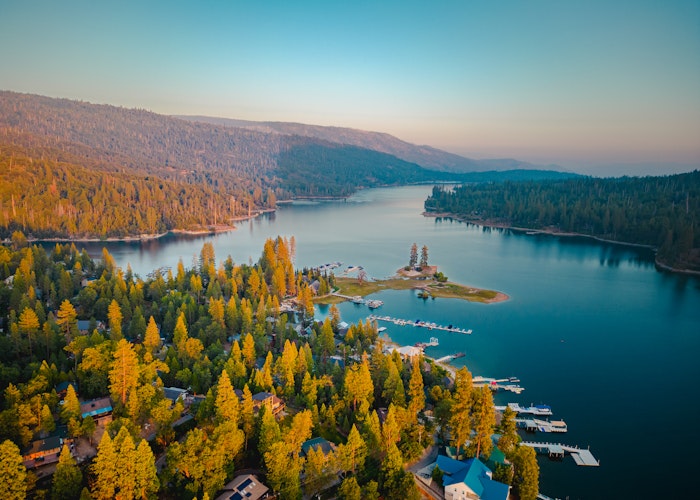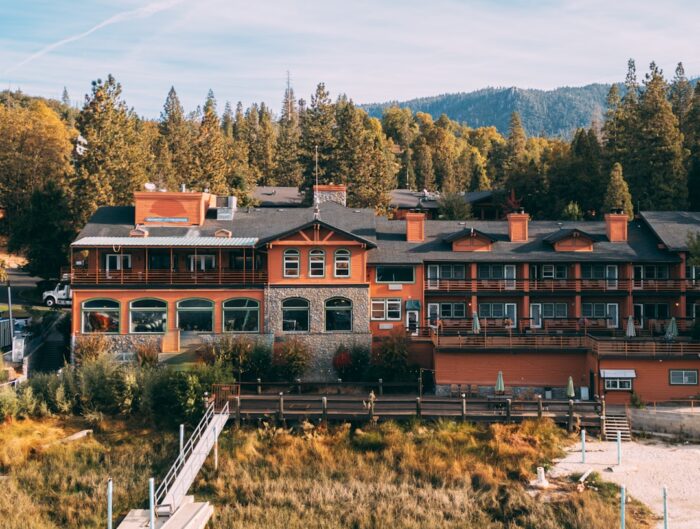If you have been to the Pines Resort in the last 10 years then you have probably met Forest the Bear in the Lobby. He has become the unofficial mascot of the Pines Resort (well, a stuffed mascot, because we also have Kash the Corgi).
Bears are so synonymous with the mountain community and California as a whole that their imagery is found on everything from t-shirts and mugs to the California Flag. If you spend any significant amount of time in the Sierra, then you have probably seen or encountered a bear in the wild. Seeing one can invoke feelings of excitement, awe and fear. Here are a few tips to keep your next encounter a safe one.

Bears
If you spot a bear in the Central Sierra around Bass Lake or Yosemite, it is an American Black Bear not a brown or grizzly. Most black bears are not actually black but brown or even reddish brown in color. This sometimes leads to confusion for visitors to the area. Despite being on the California state flag, Grizzly bears have not been found in California for almost a hundred years. Black Bears have fared much better and are a common sight in the area.
The Average male is around 250 lbs but can reach up to around 600 lbs while females only average 150 lbs. The bears tend to be their heaviest in the fall while gorging on food to prepare for hibernation. Recent Covid related closures as well as the wild fires have led to an increase of bear activity in the mountains. We thought this is a perfect time to review some safety tips.
7 TIPS FOR STAYING SAFE
If you do encounter a bear in the wild it can be an exciting experience but is important to know that their behavior can be unpredictable and while attacks are very rare, certain steps should be taken to avoid confrontation. While the desire to get the perfect Instagram bear shot or the next viral video is understandable, but it is not worth it. Don’t Do It!

#1 – Slow Down!
Every year many bears are killed in Yosemite and the surrounding mountain area by speeding cars on curvy roads. Signs are placed in the Park where these accidents have happened.
#2 – Keep Your Distance
If you come across a bear while outside of your vehicle, stay at least 50 yards away from the bear. Slowly and calmly exit the area or take a detour, always leaving an escape route for the bear. Do Not Run! Bears can run as fast as a race horse and running can trigger a chase.

#3 – Identify Yourself
Talk calmly so the bear knows you are a human and not a prey animal. Remain still; stand your ground but slowly wave your arms. Help the bear recognize you as a human.
Make yourself as large as possible by standing on higher ground. It may come closer or stand on its hind legs to get a better look or smell. A standing bear is usually curious, not threatening
#4 – Stay Calm
Remember that most bears do not want to attack you; they usually just want to be left alone.
Bears may bluff their way out of an encounter by charging and then turning away at the last second. Bears may also react defensively by woofing, yawning, salivating, growling, snapping their jaws, and laying their ears back. Continue to talk to the bear in low tones; this will help you stay calmer, and it won’t be threatening to the bear. A scream or sudden movement may trigger an attack. Never imitate bear sounds or make a high-pitched squeal.
.
#5 – Hike in Groups
Groups of people are usually noisier and smellier than a single person. Therefore, bears often become aware of groups of people at greater distances, and because of their cumulative size, groups are also intimidating to bears.

.
#6 – Do Not Feed the Bears
Protect your food from bears by not leaving any in your car or packs without using a bear canister for storage. Bears in the Yosemite area have been known to break into cars through windows, bending door frames, and clawing through back seats to get to the trunk.
#7 – Watch out for Cubs
Never place yourself between a mother and her cub, and never attempt to approach them. The chances of an attack escalate greatly if she perceives you as a danger to her cubs.
If you are are going to be spending several days hiking or camping in the back country, consider carrying a canister of bear spray. When used properly, bear spray can be a safer and much more efficient deterrent than a firearm.







Leave A Reply